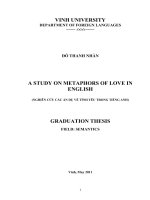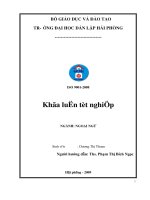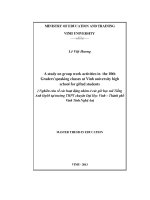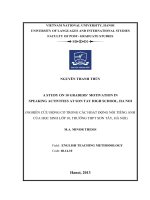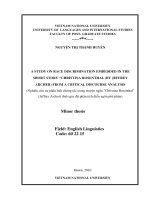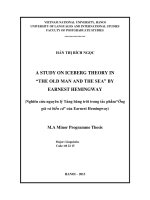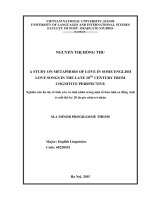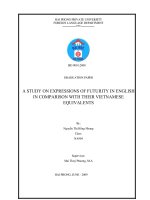a study on theory of iceberg in the old man and the sea by earnest hemingway = nghiên cứu về nguyên lý tảng băng trôi trong tác phẩm ông già và biển cả của ernerst hemingway
Bạn đang xem bản rút gọn của tài liệu. Xem và tải ngay bản đầy đủ của tài liệu tại đây (515.73 KB, 49 trang )
VIETNAM NATIONAL UNIVERSITY, HANOI
UNIVERSITY OF LANGUAGES AND INTERNATIONAL STUDIES
FACULTY OF POSTGRADUATE STUDIES
****************
HN TH BCH NGC
A STUDY ON ICEBERG THEORY IN
“THE OLD MAN AND THE SEA” BY
EARNEST HEMINGWAY
(Nghiên cư
́
u nguyên ly
́
Ta
̉
ng băng trôi trong ta
́
c phâ
̉
m “Ông
gi v bin c” ca Earnest Hemingway)
M.A Minor Programme Thesis
Major: Linguistics
Code: 60 22 15
HANOI – 2013
VIETNAM NATIONAL UNIVERSITY, HANOI
UNIVERSITY OF LANGUAGES AND INTERNATIONAL STUDIES
FACULTY OF POSTGRADUATE STUDIES
****************
HN TH BCH NGC
A STUDY ON ICEBERG THEORY IN
“THE OLD MAN AND THE SEA” BY
EARNEST HEMINGWAY
(Nghiên cu nguyên l Tng băng trôi trong tc phm “Ông
gi v bin c” ca Earnest Hemingway)
M.A Minor Programme Thesis
Major: Linguistics
Code: 60 22 15
Supervisor: Assoc. Prof. Nguyê
̃
n Xuân Thơm Ph.D
HANOI - 2013
iv
TABLE OF CONTENTS
Page
Acknowledgement ii
Abstract iii
Table of contents iv
PART A: INTRODUCTION
1. Rationale of the study 1
2. Aims and objectives of the study 3
3. Research questions 3
4. Design of the study 4
5. Methods of the study 4
4. Scope of the study 4
PART B: DEVELOPMENT
CHAPTER 1. LITERATURE REVIEW
1.1. Theoretical background
1.1.1. Discourse and Critical discourse analysis 6
1.1.2. Literary style 8
1.1.3. Language use 9
1.2. Analytical background
1.2.1. Introduction to “The Old Man and the Sea” 11
v
1.2.1.1. Plot overview 13
1.2.1.2. Themes in “The Old Man and the Sea” 13
1.2.1.3. Setting of „The Old Man and the Sea” 13
1.2.1.4. Characters in “The Old Man and the Sea” 15
1.2.2. Hemingway‟s Iceberg Theory 15
1.2.2.1. Introduction to the Theory 16
1.2.2.2. Features of Hemingway‟s Iceberg Theory 17
CHAPTER 2. THEORY OF ICEBERG
IN THE OLD MAN AND THE SEA
2.1. The above part of the iceberg 121
2.2. The hidden part and its components 22
2.2.1. Setting 24
2.2.2. Characters 25
2.3. Literary devices for Iceberg theory
2.3.1. Language style 26
2.3.2. Narrator style 27
2.3.3. Characters‟ discourse 29
2.3.4. Symbolism 31
2.3.4.1. The character Santiago 32
2.3.4.2. The marlin 34
vi
2.3.4.3. The sharks 35
2.3.4.4. The sea 36
2.3.4.5. The lions 37
2.3.4.6. The mast 38
PART C. CONCLUSION
1. Summary 40
2. Limitations 41
3. Suggestions for further study 42
REFERENCES 43
1
PART A. INTRODUCTION
This initial part stated the problem and the retionale of the study, together with the
aims, objectives, the scope of the study, and the overview of the rest of this paper.
Above all, it was in this part that the research questions were identified to work as
clear guidelines for the whole research.
1. Rationale of the study
Earnest Hemingway (1899 - 1961), also known as ―Papa‖, occupies a prominent
place in American Literature by virtue of his revolutionary role in the arena of 20
th
century American fiction. The period 1940-1950 was perhaps the bleakest ten
years in Hemingway‘s writing career when his last major work ―Across the River
and into the Trees”, which he considered his best work ever, met with severe
negative criticism of unintentional self-parody. However, the publication of the
next work, The Old Man and the Sea, in one edition of Life magazine in 1950 was
an instant success. Some viewed the story as Hemingway‘s symbolic attack on
literary critics—the elderly master fighting and triumphing over his long-time
adversaries. The novella soared to the top of the best-seller list and remained there
for six months. At first glance, the story appears to be an extremely simple story of
an old Cuban fisherman (Santiago), who catches an enormously large fish then
loses it again. But, there's much more to the story than that. ―The Old Man and the
Sea” helped to revive Hemingway's reputation as a writer of great acclaim. This
slim volume won the Pulitzer Prize in 1953 and also contributed enormously to
Hemingway's recognition as a world-renowned writer with the award of the
Nobel Prize for literature in 1954. As a writer, Hemingway became known for his
predominant them of "grace under pressure." This theme was clearly developed in
the character Santiago who fought the giant fish and killed it against all odds; it
also characterized Hemingway‘s own life until the point in his life when he felt he
was no longer able to demonstrate grace under pressure.
2
The Old Man and the Sea is believed to be Hemingway's best work, and no less
than William Faulkner (1977) said, "Time may show it to be the best single piece
of any of us, I mean his and my contemporaries”. It ranked one of the best-known
books and it was also taught at school. This classic novella proves to be a must-
read for those who are interested in Hemingway‘s literary work as well as his
legacy to American literature.
Moreover, as the last piece of writing Hemingway published in his life, The Old
Man and the Sea typically reflects his unique writing style. Hemingway language
in The Old Man and the Sea is simple and natural on the surface, but actually
deliberate and artificial. The language is rarely emotional. Rather, it controls
emotions by holding them in. Theory of Iceberg, the most notable in Hemingway‘s
writing style, is also reflected clearly in this novel. The "Iceberg Theory" can be
explained as such: If a writer is worth anything, and is actually going to create a
piece of art in words, he must follow this theory. The author's short story must
omit items that are obvious or are already stated by metaphors, similes, or some
other figures of speech. The author should do this to the point where the reader
must think, understand, and really delve into the character and the words that are
used to understand the entire story. In this way the words on the page are merely
1/8 of the story itself, it is the other 7/8 that the story truly lives in. Moreover,
Hemingway's Iceberg theory highlights the symbolic implications of art. He makes
use of physical action to provide an interpretation of the nature of man's existence.
It can be convincingly proved that, "while representing human life through
fictional forms, he has consistently set man against the background of his world
and universe to examine the human situation from various points of view."
(Halliday, 1956)
For the reasons above, the researcher carried out this study with the hope to have
better insights into Hemingway‘s literary work and also his impact on the whole
American literature. Although The Old Man and the Sea is only one of the great
3
novels of the author, it sets an excellent illustration of his writing principle and
literary ideology.
2. Aims and objectives of the study
This study aims at analyzing Hemingway‘s Theory of Iceberg in The Old Man and
the Sea. As the greatest principle of Hemingway‘s writing style, the theory
provides readers an obvious overlook of the writer‘s literary career. In terms of art
value, the answer to this matter would help the student of Linguistics, the novel‘s
readers as well as those who wished to specialized in American Literature realize
what made Hemingway one of the most successful authors in literature arena.
In terms of reality value, understanding Theory of Iceberg could help readers
discover the story‘s purpose through some underlying principle nit readily
apparent in the text. Hemingway believed the true meaning of a piece of writing
should not be evident from the surface story because the crux of the story lies
below the surface. This tale of an aged Cuban fisherman going head-to-head (or
hand-to-fin) with a magnificent marlin encapsulates Hemingway's favorite motifs
of physical and moral challenge. If a younger Hemingway had written this novella,
Santiago most likely would have towed the enormous fish back to port and posed
for a triumphal photograph just as the author delighted in doing. Instead his prize
gets devoured by a school of sharks. Returning with little more than a skeleton, he
takes to his bed and, in the very last line, cements his identification with his
creator: "The old man was dreaming about the lions." The tale of The Old Man
and the Sea is obviously a hymn to human courage and endurance.
As a linguistic student, the researcher expected to find out and briefly analyze the
significance of language used in The Old Man and the Sea exposing Hemingway‘s
striking writing style. The finding of this would help the students of linguistics ,
the novel‘s readers as well as those who wish to specialized in American
Literature realize what made Hemingway one of the most influential authors of the
century.
4
3. Research questions
The general goal of this research is to look into Hemingway‘s Theory of Iceberg in
The Old Man and the Sea which can at least partly contribute to findings in
literary appreciation and reading comprehension. To this end, this research tries to
answer the following questions:
1. What is Hemingway‘s Theory of Iceberg?
2. How is the Theory revealed in The Old Man and the Sea?
3. What can be withdrawn from the surface of the story?
4. Design of the study
This paper is organized in the following way:
Part One presents a general introduction of the research containing the rationale,
aims and objectives, methodology and scope of the study. Part Two gives a
theoretical and analytical background for the study. Part Three goes into details
about Iceberg Theory in the novel with an emphasis on the hidden part of the
iceberg. The conclusion can be found in Part Four, which includes a summary,
limitations of the research as well as suggestions for further study.
5. Methods of the study
Descriptive and contextual methods of data collecting and analyzing are used in
the research.
First, relevant literature, publications and studies were reviewed in order to get in-
depth information on Hemingway‘s writing style in general and Theory of Iceberg
in particular. Also country specific information on the organic horticultural sector
was reviewed. Second, the researcher analyzes and agglutinates those ideas into
her own comprehensible viewpoints. Finally, the information was analyzed and
processed. Evidence is taken from the story and analyzed based on the
researcher‘s knowledge to put a light on how Hemingway used Theory of Iceberg
in his novel.
6. Scope of the study
5
The study focuses on how Hemingway exposed his striking writing style in The
Old Man and the Sea. To find the answer to the question, full attention was paid to
the conversations between characters, the symbolic images and the mood flow of
the characters.
The researcher also placed great emphasis on the language used in the novel. In
The Old Man and the Sea, Hemingway practiced his familiar short and concrete
language but filled with emotions. In contrast to Romantic writers who often
emphasize on abundance, Hemingway is a classicist in his restraint and
understatement. He believes that the strongest effect comes with an economy of
means. Therefore, understanding Hemingway‘s writing style can help readers
draw valuable lessons in reading comprehension.
6
PART B. DEVELOPMENT
Chapter 1. Literature Review
1.1. Theoretical Background
There were several key terms: discourse and critical discourse analysis, literary
style and language use, which needed to be deeply understood. So for the purpose
of providing a clear and deep understanding of the matter, this first chapter would
focus on the definitions of those key terms while mentioning some necessary
information about previous studies that related to the matter of the study.
1.1.1. Discourse and discourse analysis
Through centuries, 'discourse' was defined in various ways by a number of
scholars and their discussions became an art, which drew a lot of attention from
the later authors.
‗Discourse‘ was 'stretches of language perceived to be meaningful, unified and
purposive'. (Cook 1989:156)
‗Discourse‘ was considered 'a communicative event which draws on the meaning
potential of the language (and other systems of communication) to carry
communicative value (the illocutionary force) of speech acts through utterances.
In other words, it referred to “the interpretation of communicative events in
context.” (Nunan 1993:7-8)
It could be said that there were no significant differences between those definitions
since the notion of ‗discourse‘ was all about how the language use was understood
in such verbal events.
Sharing a lot in common with Malinowski, linguists (Hymes, 1960s; Austin, 1962;
Searle, 1969; Grice, 1975; and Halliday and Hasan, 1973, 1978, 1989, 1994) had
drawn certain attention to this branch by clarifying some “contextual, grammar
7
and cohesional models as well as pragmatic and conversational viewpoints”,
which were very clear and essential.
However, at the limitation of the minor thesis, the researcher wanted to focus on
the role of contextual analysis in the three major discourses for the reason that
'context' was created by the discourse and vice versa. It was what and how people
could depend on to interpret the discourses created in each context as Nunan
(1993:7-8) cited that J.R. Firth and Dell Hymes also appreciated the idea that
people always reacted toward how they understood and predicted what the others
were going to say next.
More systematically and clearly than Malinowski, a great British anthropologist
who significantly contributed in clarifying two types of ‗context‘: Context of
Situation and Context of Culture, Halliday (1989) developed a model of
contextual analysis, just following the context of situation, which included three
components as followed:
Components of a
SITUATION
Feature of the context
Field of discourse
what was happening, to the nature of the social action
that was taking place
Tenor of discourse
Who were taking part in the situation
Mode of discourse
The role assigned to language
8
Example 1:
A short conversation was given and analysed in Halliday and Hasan‘s theory
(1989) as an example:
Doctor: Have you been vomiting?
Patient: Em, yeah. I vomitted about … I vomitted twice … two days ago at school
and I vomitted about um eight or ten times last night.
Patient: Oh, er, just sort of altogether, you know, Dr M gave him anti-biotic
capsules for him to take because he's also got …
Doctor: a throat.
Patient: A bit of infected tonsils yeah and he said that, you know for him to spit
the capsule out … I don't know whether he was trying to swallow it down or what
but he did.
Doctor: Ah Look, I don't think you can go past an appendix there. Just, you know,
number one, he's got no pain just there and is sore there and I think he's probably
got something blocking in the appendix and it's giving him this constant pain and
trouble. So seeing that you've had it for some time and been worse lately I think it
certainly would be wise to think about having done.
(Halliday and Hasan,1989)
9
Analysis of Example 1
Components of a
SITUATION
Feature of the context
Field
A child-patient that influenced the choice of lexical items
Tenor
A doctor and a patient
Mode
The choice of lexical items: parts of the body: throat, tonsil,
appendix; bodily actions: vomit, spit, swallow
Example 2
A: Hi! I didn't know you belonged to the national Film Theatre. Have you been a
member for long?
B: No, I joined only last week. It's good, isn't it?
A: Yes, it is. There's always an excellent selection of films here. I'm just going to
get a coffee. Would you like one?
B: I'm really thirsty. Oh, don't forget that I've given up sugar.
(Hoang Van Van Ph.D, 2006)
Analysis of Example 2
Components of a
SITUATION
Feature of the context
Field
An informal conversation between friends in a cafeteria
Tenor
Two friends
Mode
Use of words related to theatre: film, member; cafeteria:
thirsty, coffee, sugar
10
In the field of Literature, no matter what the story was, the conversations might be
between or amongst people in a certain circumstance, but it was Mode that
perfectly helped recognize and distinguish an author's literary style from others'.
1.2. Literary style
Literary style was defined in various ways by a number of scholars.
According to Geoffrey Leech and Mick Short, Literary style referred to “linguistic
choice in general” or to ―those aspects of linguistic choice which concern
alternative ways of rendering the same subject matter” (cited by Mitchell, A. &
McGee, K. 2011: 31-32).
Much more clearly in ―Linguistics and literary style‖ (1970), Donald C. Freeman
once clarified the literary style into some categories: sentence structure, pace,
vocabulary, figures of speech, use of dialogue, tone, etc.
Similarly with those scholars, David Watson in ‗The Elements of Style‘ (1915),
defined literary style as ―the translation of thought into language”. This
identification of the style surely did not fail in ―width and generality”. In other
words, there was no doubt, as the widespread belief in the existence and the power
of something so called when words, sentences and voice were carefully chosen to
be the means or the medium of the garment of the certain processes of thought. It
gave a distinction to certain writers or compositions because even though it was
not so easy to recognize an author‘s style, readers were still able to see her literary
accent of a school, a nation or an age which could be clarified through the concrete
whole form by means of a number of concrete parts.
Although literary style was defined in various ways, it was known in conclusion as
the element that described an author‘s choice of words, sentence structures,
figurative language and the habit of correct grammar, arrangement of all her work
together to establish mood, images and meaning of the text. In the limitation of
this minor study, the researcher would focus on three main elements, which were
11
known in the necessity of Mode in Halliday‘s theory, as David Watson (1915) and
Strunk W. and White E.D. (2000) once again agreed.
1.2.1. Word choice
General speaking, nouns and verbs were the main medium, which helped readers
visualize and convey the meanings of a novel, and a novel writer was said to be
good only if she knew when to choose or weed out the words concisely and
precisely. It should be words which were “active verbs, concrete nouns and
specific adjectives” (cited in ‗The Elements of Style‘, 2000).
1.2.2. Sentence fluency
Easily seen in well-known novels that readers mostly were attracted by a variety
of sentences with different lengths and rhythms which was called “the flow and
rhythm of phrases and sentences”; in other words, it was ‗Sentence fluency‘. All
the ideas were carefully considered, chosen and then arranged in various structures
to reflect the main themes of the novel. They were not like in speaking when
people could not rethink or revise the ideas for effect. To make the sentences
fluent, sounding like an own style, the writer would re-choose the words, delete
redundancies, make vague or ambiguous words much clearer to convey the
greatest effect as possible.
1.2.3. Voice
Lord Chesterfield once shared: “Style is the dress of thoughts”; and Literary style
was most clearly defined by an author‘s voice. Although voice was difficult to be
drastically measured, it was the essential element that revealed the writer‘s
personality to the extreme; and in ‗Pride and Prejudice‘, Jane Austen was
successful in portraying characters with a great sense of irony.
“Irony is a form of utterance that postulated a double audience, consisting of one
party that hearing shall hear and shall not understand, and another party that,
12
when more is meant than meets the ear, is aware both of that more and of the
outsiders’ comprehension” (Fowler 1968, 305)
In those hidden language, actions, differences and communications, irony was
seen as an art or a means of worth and effective persuasion in speeches when it
allowed people to convey the meaning above what was said. As Socrates (cite by
Colebrook, 2004) once implied, irony was used by saying one thing and meaning
another which resulted in an insistence. Irony was believed to bring about ―truth
and recognition” even if that truth was hard to be recognized and not fully
meaningful.
1.3. Language use
Language use was said to be ―the people’s production and understanding of a set
of sentences with particular meanings‖ (Clark, 1993). In other words, the choice
of words had to be suitable for each communication circumstance so as to express
different meanings, those needed to be clarified and deeply understood in order to
keep up with the chains of following activities. In those activities the speakers said
and took actions by using words whilst the others had to coordinate with them in
trying to comprehend what they meant.
13
1.2. Analytical Background
1.2.1. Introduction to The Old Man and the Sea
1.2.1.1. Plot Overview
Plot is a literary term defined as the events that make up a story, particularly as
they relate to one another in a pattern, in a sequence, through cause and effect,
how the reader views the story, or simply by coincidence. One is generally
interested in how well this pattern of events accomplishes some artistic or
emotional effect. An intricate, complicated plot is called an imbroglio, but even
the simplest statements of plot may include multiple inferences.
The Old Man and the Sea is undoubtedly Hemingway‘s masterpiece, winning the
Pulitzer Prize in 1953. It is a simple story about an old poor fisherman Santiago
and his battle with a great marlin. For 84 days Santiago does not catch a single fish
but he does not feel discouraged. He goes far into the sea again and hooks a giant
marlin. In a desperate struggle, Santiago manages to kill the fish and tie it to his
boat, only to find that on the way home he has to fight a more desperate struggle
with some dangerous giant sharks which eat up the marlin, leaving only a
skeleton. The old man brings it home and goes to bed to dream again. The struggle
leaves him with exhaustion but wins him much respect among the villagers.
1.2.1.2. Themes in The Old Man and the Sea
Theme is an idea or concept that is central to a story. A theme may be exemplified
by the actions, utterances, or thoughts of the characters in a novel.
Within a simple plot about an old poor fisherman, Hemingway praises the themes
of human pride and honor over struggle, defeat and death. A heroic man like
Santiago should have pride in his actions, and as Santiago shows us, "humility was
not disgraceful and it carried no loss of true pride" (14). At the same, though, it is
apparently Santiago's pride which presses him to travel dangerously far out into
the sea, "beyond all people in the world," to catch the marlin (50). While he loved
the marlin and called him brother, Santiago admits to killing it for pride, his blood
14
stirred by battle with such a noble and worthy antagonist. Some have interpreted
the loss of the marlin as the price Santiago had to pay for his pride in traveling out
so far in search of such a catch. Contrarily, one could argue that this pride was
beneficial as it allowed Santiago an edifying challenge worthy of his heroism. In
the end, Hemingway suggests that pride in a job well done, even if pride drew one
unnecessarily into the situation, is a positive trait.
The story also underlines honor in struggle, defeat and death. From the very first
paragraph, Santiago is characterized as someone struggling against defeat. He has
gone eighty-four days without catching a fish—he will soon pass his own record
of eighty-seven days. Almost as a reminder of Santiago‘s struggle, the sail of his
skiff resembles ―the flag of permanent defeat.‖ But the old man refuses defeat at
every turn: he resolves to sail out beyond the other fishermen to where the biggest
fish promise to be. He lands the marlin, tying his record of eighty-seven days after
a brutal three-day fight, and he continues to ward off sharks from stealing his prey,
even though he knows the battle is useless. In the very last sentences of the story,
though sleeping deadly with exhaustion, the old man is still ―dreaming about the
lions‖. As Santiago himself says, "Man is not made for defeat A man can be
destroyed but not defeated" (103). The tale is a hymn to human courage and
endurance.
1.2.1.3. Setting of The Old Man and the Sea
This short novel, as the title suggests, is mainly set on the sea over a period of
three days. The setting is important because marlin are found only in certain
locations and the author needed a tropical location for the story, like the Gulf of
Mexico.
On land, the action takes place in a small village on the northern coast of Cuba,
below the Tropic of Cancer and not far from the capital city of Havana. Havana is
the capital of Cuba and forms a distant background to Santiago‘s journey; he uses
15
the lights of the city to find his way back home at night. A more important town in
the novel is the little fishing village in which Santiago lives and where Spanish is
spoken. He seems to have based the village on a real one called Kojimar. The
warm waters of the Gulf Stream flow very close to this village, bringing the giant
marlin in the months of September and October. Santiago sets out on his
momentous journey in the early fall, probably in September.
The setting of the novel is very important because Hemingway writes about man‘s
struggle, not a specific struggle of anyone. During the course of the novel, the
setting becomes symbolic; the sea represents the total universe against which
humanity (represented by Santiago) is pitted and in which, everybody has to take a
chance.
1.2.1.4. Characters in The Old Man and the Sea
Santiago, the protagonist of the novella, is an elderly widowed Cuban fisherman
whose ―luck‖ seems to have run out. He has not caught anything in 84 days.
Santiago is humble in his dealings with others, yet takes great pride in his work
and himself, and is frustrated and embarrassed by his failures. He views his aging
body as a kind of betrayer, and fondly remembers his younger days, when he was
exceptionally strong and a successful fisherman. Other than fishing, Santiago‘s
greatest joys are the time he spends with his former apprentice, Manolin, and the
time he spends talking about baseball, and, in particular, his favorite player, the
―great DiMaggio.‖ Besides Manolin, Santiago considers his only friends to be the
sea, the fish, and the stars. In his conquest over the marlin, Santiago exhibits
exceptional determination and endurance in the face of physical and psychological
pain. Although he loses the marlin to sharks, the entire struggle constitutes a
spiritual triumph in which Santiago emerges as a Christ figure.
16
Manolin is an adolescent Cuban boy who has fished with Santiago since he was a
child. Manolin is Santiago‘s devoted apprentice. He cares for Santiago in his old
age, and encourages him in his fishing even though Manolin‘s parents have forced
Manolin to seek out a ―luckier‖ employer. He is Santiago‘s only human friend,
and looks up to Santiago as a mentor and father-figure. Manolin exemplifies traits
of fidelity, selflessness and compassion. He accepts hard work happily, never
complaining.
The marlin – The giant, 18-foot fish that battles with Santiago in the middle of the
ocean for three days and three nights. Although Santiago hooks the marlin on his
first afternoon at sea, the marlin refuses to come to the surface and pulls Santiago
farther and farther from land. Santiago admires the marlin‘s beauty and endurance,
and considers it a ―noble‖ adversary and a brother, telling the fish repeatedly that
though he loves him, he must kill him.
The shovel-nosed sharks – Scavengers and little more than swimming appetites,
the shovel-nosed sharks are Santiago‘s fiercest antagonists. Although Santiago
manages to kill most of them, they tear apart the marlin‘s body and leave Santiago
devastated. While the marlin is portrayed as both an adversary and a noble
companion to Santiago, the sharks are portrayed as purely vicious.
Pedrico – Another fisherman in Santiago‘s village, Pedrico makes fish traps.
Santiago gives him the marlin‘s head at the end of the novella in gratitude for
supplying him with newspapers that report the baseball scores.
Martin – The owner of the seaside café, the Terrace, where Santiago and other
fisherman eat. Martin provides Santiago with meals during his unlucky streak.
1.2.2. Hemingway‟s Theory of Iceberg
1.2.2.1. Introduction to Iceberg Theory.
17
An iceberg has 1/8 above the water, the rest is hidden under the surface.
Therefore, what people see is only a small part of what an iceberg really is.
Hemingway compares his creation to an iceberg and use ―Iceberg theory‖ of
―Theory of Omission‖ to summarize his art style.
―If a writer of prose knows enough about what he is writing about he may omit
things that he knows and the reader, if the writer is writing truly enough, will have
a feeling of those things as strongly as though the writer had stated them. The
dignity of movement of the iceberg is due to only one-eighth of it being above
water. The writer who omits things because he does not know them only makes
hollow places in his writing‖ (Death in the afternoon, 1932)
Hemingway began his writing career as a reporter. Journalistic writing,
particularly for newspapers, focuses only on events being reported, omitting
superfluous and extraneous matter. When he became a writer of short stories, he
retained this minimalistic style, focusing on surface elements without explicitly
discussing the underlying themes. Hemingway believes the true meaning of a
piece of writing should not be evident from the surface because the crux of the
story often lies below. The Iceberg Theory can be explained as such: The author
must omit items that are obvious or are already stated by metaphors, similes or
some other figures of speech. The author must do this to the point where the
readers must think and understand the characters, the words to understand the
entire story. Hemingway keeps 7/8 of his meaning unwritten for the readers to
decipher from the 1/8 that he is writing. Actually, by omitting certain parts of a
story, the writer strengthens that story. He must be conscious of the omission and
be writing true enough in order for readers to sense the omitted parts. When they
can, a greater perception and understanding of the story can be achieved.
1.2.2.2. Features of Hemingway‟s Iceberg Theory
Hemingway‘s style includes the use of short, choppy sentences that are descriptive
and have underlying meanings that are integral to the work. Hemingway uses this
technique, the iceberg, to portray meaning and depth to a character without
18
directly stating what the reader should be thinking. The iceberg technique allows
readers to use their intelligence to figure out Hemingway‘s underlying meanings.
This writing style is effective because it involves the reader in the work by forcing
the reader to dig beneath the layer of description and find the depth of the writing.
Hemingway‘s creativity and intelligence is shown through his knowledge of the
human condition and his ability to write about people in a realistic way through
the iceberg style. Hemingway made his stories so short. They are like icebergs,
with a lot going on underneath the surface. He revised his stories carefully,
making them tighter and yet more suggestive with each version. He packed a lot of
meaning into a small amount of words.
Iceberg Theory is applied in many of Hemingway‘s novels. Besides The Old Man
and The Sea which is discussed in this paper, ―A Clean, Well Lighted Place‖
(1933) also sets an illustration. It gives account of an old man and two waiters at a
café. Third person narration sticks only to readily discernible facts, allowing the
reader to apply judgment of events and characters. He includes only essential
information, often omitting background information, transitions, and dialogue tags
such as ―he said‖ or ―she said‖. He often uses pronouns without clear antecedents,
such as using the word it without clarifying what it refers to. Hemingway also
rarely specifies which waiter is speaking in the story because he has deemed such
clarification unnecessary. The essential element is that two waiters are discussing
a drunk old man—the rest can be omitted according to Hemingway‘s economy of
style. When the older waiter contemplates the idea of nothingness, Hemingway
loads the sentences with vague pronouns, never clarifying what they refer to: ―It
was all a nothing. . . . It was only that. . . . Some lived in it . . .” Although these
lines are somewhat confusing, the confusion is the point. This nothingness can’t
be defined clearly, no matter how many words are used. Hemingway uses fewer
words and lets the effect of his style speak for itself. He is also often unclear who
is even speaking, leaving the reader to decide on their own.
19
―Hills Like White Elephants‖ (1927) is another short story reflecting this theory. It
is about an American couple waiting for a train to Madrid. The plot of the story is
not written in the prose. The girl is pregnant and the couple are discussing an
abortion. The plot is only evident when the reader considers the setting,
symbolism and dialogue. The setting is incomplete at the beginning of the story
but additional details sneak in slowly. The author added trees to the distant hills in
stark contrast to the barren area of the station. He compared the white hills to
white elephants ―fields of grain and trees mountains [and] a cloud [moving]
across the field”(35) to provides the final demonstration of the fertility of the area
of the hills. In the story, no meaningful dialogue occurs about the operation. When
the man is contradictory, he says ―I think it’s the best thing to do. But I don’t want
you to do it if you don’t really want to‖(34). The girl unfairly requests such as
―You won't ever worry‖(34) The dialogue ends with the action of the man rejecting
the girls suggestion to ―finish the beer‖(36) together after the bags are moved.
Symbolism is also applied. The abortion is supported by the imagery of the barren
train station contrasted with the fertile farmland in the distance. When both the girl
and the Catholic Church oppose the abortion, the man mysteriously walks through
the ―rosary‖ beads near the end of the story. The girls stresses inclusiveness in
speech; reflecting her desire to include both the man and the unborn baby in her
life while the man stresses independence in his speech; stressing the importance of
not being tied down with a baby and possible not even the girl. Until the end of the
story, nothing is clear. The reader is expected to decide from the clues the man and
girl's fate. Did they return to Barcelona and ―have everything‖(35) as the main
finally passing through the ―rosary‖ beads implies? Did the man establish his
independence from the girl as the solitary drink at the bar implies? Readers have
their own answers, as Hemingway said ―Read anything I write for the pleasure of
reading it. Whatever else you find will be the measure of what you brought to the
reading‖(Plimpton 128-29) -Ernest Hemingway.
20
Hemingway‘s economical writing style often seems simple, but his method is
calculated and used to complex effect. He believes that a writer could treat the
subject honestly only if the writer had participated in or observed the subject
closely. His stylistic influence on American writers has been enormous and the
Iceberg Theory is also commonly adopted by many writers around the world
today.
